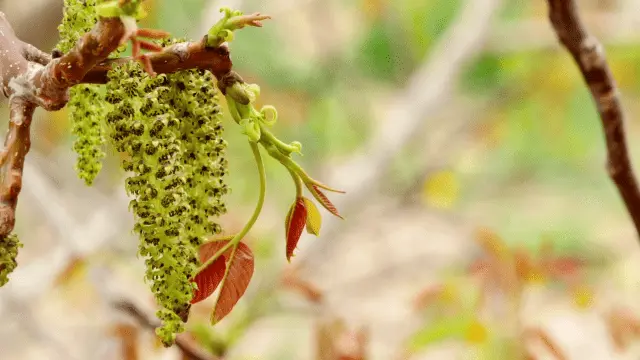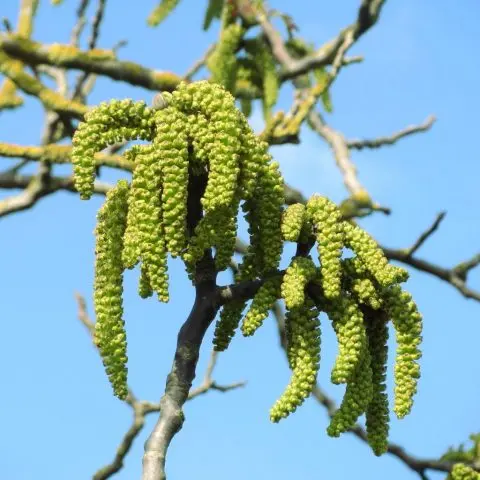Contents
Some gardeners are faced with the problem of why the walnut does not bloom. Its fruits contain a large amount of useful substances and vitamins, are used in cooking, cosmetology and medicine. By following a number of the rules described in the article, you can easily achieve flowering plants.
How does a walnut bloom?
The tree blooms from April to May. Walnut flowering lasts about 15 days. At the same time, both female and male flowers can be on it. Female ones are located at the top of the annual shoot singly or in several pieces. The male stamens look like dangling catkins tightly assembled in the axils of the leaves. Below are a few photos of walnut blossoms.


Walnut flowers are small, light greenish in color. Pollinated by wind and pollen from other walnut trees within a radius of 1 km. As a result of pollination, the formation of fruits occurs.
The fruits are large nuts with a thick green peel 0,5 – 2,2 mm thick and a dense stone with several partitions. When the fruits ripen, the peel dries up and bursts into 2 parts. A woody shell remains, inside of which the edible core itself is enclosed. Ripening occurs in August and September. Nuts can be both small and large: it depends on the variety and where the tree grows. The shape of the fruit is usually round, oval or ovoid.
After planting from seed, fruiting occurs in 8-12 years. Every year, from 10 to 300 kg of fruits are obtained from one tree. On a garden plot, a walnut lives for about 200 – 500 years, in the wild – up to 1 thousand years, and sometimes longer.

Why does the walnut not bloom
To grow a nut that can enter the fruiting season, you need to properly study the biological characteristics of the flowering of this plant.
Variety and method of planting
There are short, medium and late varieties of varieties. In order to quickly achieve the color of a walnut, it is necessary to know the heredity of the individual from which the seeds or cuttings were taken.
Absence of a partner
It is known that the walnut is a dioecious plant, however, its flowering has three forms.
Protandric | Protogonic | self fertile |
First, the male flower blooms, and after a certain time, the female flower. | At first, the female one dissolves, and after it – the male one. | Flowering of female and male inflorescences begins at the same time. |
If the female inflorescences have not opened by the time the male ones release pollen, the tree will not bear fruit. | If the male flowers have just blossomed, and the female ones have already faded, there will be no harvest. | The plant self-pollinates and may subsequently bear fruit. |
Protandric and protogonic individuals are simply not able to fertilize themselves, they need a pollinator during flowering.
Too much fertilizer
If the tree is actively growing, but flowering does not occur, this means that the owners fertilize and water it too generously. This contributes to the beginning of enhanced development of the roots, and other processes are inhibited or suspended altogether.
Abundant crown density
If the tree has a lot of rare short young shoots, it is too dense. Walnut flowering occurs with moderate crown density. This makes the pollination process better, as the wind is free to capture and move the pollen.
Unsuitable conditions and diseases
Both at low and at extremely high humidity, walnut pollination is impossible. Especially if during flowering there are prolonged cold rains.
The soil for growing is also important. Walnut does not like acidic environments, and the most productive trees are found on lime-rich soils.
Among other things, flowering does not occur because the tree may be sick or infested with parasites.
What to do if the walnut does not bloom

- To speed up fruiting time, graft an individual with an “eye” of another walnut, similar in flowering cycle.
- If the walnut tree is not self-fertile, introduce a partner to it. It must be selected in such a way that the periods of maturation of male and female flowers coincide in plants.
- Another option is to use a branch from another plant with pollen in time and shake it over a fruitless tree. Or lay out drop-down earrings on a sheet of paper and leave to ripen for a day. Then collect the pollen in a cloth bag and spray over the plant during its flowering. Such pollen can be stored for 1 year.
- If the concentration of fertilizers in the soil is exceeded, it is required to stop complementary feeding and watering until the walnut returns to normal. If this does not help, prune the root system. To do this, move to a distance of 1,5 m from the trunk and dig a groove around it in width and depth equal to a shovel.
- With abundant crown density, cut off excess branches.
- When the soil is depleted, it must be dug up using a pitchfork. Use 3-4 buckets of humus as fertilizer, cover with mulch.
- In drought, the plant needs a lot of water, but it is not recommended to use more than 100 – 150 liters.
- Nut moths, mites, white butterflies and codling moths can be eliminated by hand picking parasites and their larvae. Another option is spraying with specialized solutions. During flowering and fruiting, spraying walnuts is prohibited.
- Diseases such as marsonia, bacteriosis and root cancer need to be diagnosed and treated in time.
Diseases: methods of treatment
Marsonia | Bacteriosis | Root cancer |
Fungal attack. Red-brown spots form on the leaves. They grow and eventually affect the entire surface, then move on to the fruits. | Fruits and leaves are affected, this leads to their fall and deformation. | Cancer is a developmental stop. Small tubercles appear on the stem and roots. The plant does not receive nutrients and water from the earth, does not bloom, gradually begins to fade. |
The reason is the high rainfall. | Too abundant watering or frequent rains, fertilizing with products containing nitrogen. | A soil-dwelling bacillus that penetrates roots through cracks. Drought. |
Prevention – spray the crowns of trees diluted in water with quicklime and blue vitriol in proportions of 1: 1. Repeat 3 times. Remove affected leaves and burn. | Before flowering, treat the walnut three times with a remedy for marsonia. Also collect and burn the affected parts of the plant. | Cut off the overgrown tubercles, treat with liquid caustic soda, rinse with water. |
Conclusion
Knowing the biological characteristics of the plant and the intricacies of caring for it will help you achieve the desired results and see with your own eyes how the walnut blooms. The start time of flowering mainly depends on genetic characteristics, growing conditions, soil and crown formation system. All difficulties are most often solvable, so do not rush to cut down an unfruitful tree.









